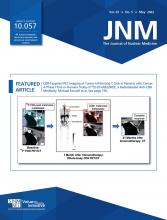REPLY: We read with interest the letter to the editor by Langen and colleagues in response to our recent study published in The Journal of Nuclear Medicine (1). We agree with them that radiomics analysis is a promising approach for PET imaging in neurooncology, although its application in clinical practice needs to be defined more precisely on the basis of the clinical question at hand. The added value of 6-18F-fluoro-l-DOPA (18F-FDOPA) PET radiomics over conventional static analysis, derived from SUV parameters, appears to hold more promise for the initial diagnosis (1) than for detecting recurrent disease (2). Extensive effort is also needed to study these radiomics tools prospectively, including in a real clinical setting of nonglioma lesion, as well as to make these tools available and amenable to accurate interpretation by nuclear physicians in clinical routine practice. We would like to respond to this letter by raising 3 points.
First, and from a methodologic point of view, radiomics analysis needs to be compared with a robust benchmark (3,4). Immunohistologic analysis of tumor samples is still considered the gold standard for defining brain tumors at the initial diagnosis. Although these analyses are considered as the reference in oncology, we know that they suffer from several limitations. Information extracted from immunohistologic analysis is representative of only the region from which the sample was taken and of only the time of collection, which means that this type of analysis is both spatially (5–7) and temporally limited (8). In this vein and for lack of a better alternative, the recently published retrospective amino acid PET radiomics studies exploring the prognostic benefits of molecular parameters of brain tumors at initial diagnosis were, similarly to ours, all based on immunohistologic analyses (9–11). In differential diagnoses, brain tumors, brain inflammatory lesions, ischemia, or primary central nervous system lymphomas are typically “do not touch” lesions (12), with correspondingly very low rates of available histologic analyses, which restricts their inclusion in these types of retrospective studies. In their study, Renard et al. (13) underline that less than one third of their pseudotumor patients had available histology.
Second, PET imaging in neurooncology needs be interpreted in the era of multimodal and multiparametric approaches as advocated by the current European guidelines, which recommend amino acid PET at the initial tumor diagnosis as an adjunct to MRI (14). High-grade gliomas may be accurately distinguished from primary central nervous system lymphomas using morphologic MRI (15), with recent MRI technical advances expected to further increase performance in differentiating from inflammatory brain lesions (16). These improvements in MRI-based brain lesion characterizations will allow more specific identification of the best candidate brain lesions to refer for amino acid PET imaging. Moreover, conventional static analysis of 18F-FDOPA PET imaging is also useful in discriminating between pseudotumoral and tumoral lesions (13).
Finally, the 2 amino acid PET studies mentioned by Langen and colleagues (1,11) reported the prognostic significance of dynamic parameters, obtained from VOI-based or voxel-based extractions combined with radiomics analysis, for respectively predicting IDH and TERTp mutations. As already extensively discussed elsewhere (17), aggressive brain gliomas are associated with high tracer uptake within the first few minutes after injection followed by a decrease in the uptake curve, whereas less aggressive gliomas typically show a slow increase in amino acid uptake, with the highest values observed at later time frames. Amino acid PET imaging of brain inflammation is also associated with a consistently increasing SUV curve (14). Figure 1 provides representative 18F-FDOPA PET images of a brain inflammation case. Other dynamic amino acid PET studies also suggest that lymphomas (18) and benign lesions (19) show dynamic patterns similar to the ones observed in less aggressive gliomas. Dynamic PET imaging of brain lesions at the initial diagnosis, in addition to conventional static analysis (13), should therefore help identify nonglioma brain lesions. This possibility will, of course, need to be further confirmed by well-designed prospective studies.
Axial slices of inflammatory lesion of midbrain (arrows) in hypersignal fluid-attenuated inversion recovery MRI (top left panel), showing moderate 18F-FDOPA uptake in PET image (top middle panel) and PET/MR image (top right panel) in 68-y-old woman. Interestingly, dynamic acquisitions (bottom panel) showed constantly increasing SUV curve suggestive of nonaggressive lesion.
To summarize, radiomics analysis of amino acid PET imaging has the potential to emerge as a truly effective tool for the noninvasive characterization of gliomas, provided that multimodal and multiparametric imaging is used. Currently, the primary aim of radiomics analyses in neurooncology is to generate hypotheses with promising results, to consider in a next step toward prospective evaluation in the real clinical setting.
ACKNOWLEDGMENT
We thank Petra Neufing for critical review of this letter.
Footnotes
Published online Mar. 17, 2022.
- © 2022 by the Society of Nuclear Medicine and Molecular Imaging.








